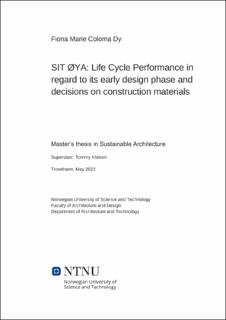| dc.description.abstract | Construction industries play a large role in contributing to the environmental problems. The building constructions in the future are inevitable, therefore we can only prevent the emission of hazardous gases. Construction materials have high embodied energy, resulting in a significant amount of carbon dioxide (CO₂) emissions. There are factors to decarbonize the building sector by considering the building material selections, material supply, lifetime, and reuse and recycling to optimize material use in reducing embodied emission. Life Cycle Assessment (LCA) promotes sustainable construction by providing a better understanding of the environmental impacts of the materials on the building. Integrating LCA on early design phase will influence the overall embodied emission of the building, a thorough selection of material with low environmental impact will help reduce greenhouse gas emission (GHG). Embodied emission of materials from production stage (A1-A3) used in the case study with 5 different scenarios [existing building (concrete vs. wood), refurbishment with extension and new constructed building (concrete v. wood)]. They are compared and calculated using Revit for the material quantities and OneClickLCA tool to calculate the embodied emission of materials and how it impacts each scenario. With existing buildings responsible for a major contribution to GHG emission, the result shows that existing building has a high GHG emission even with a lesser floor area than the other scenarios because it was made of pure concrete. Refurbishment scenario shows it has 24% lower GHG emission than constructing a new building, reusing the existing building reduces the GHG emission by avoiding demolition. Result indicates preliminary and are based on limited data information. Further work includes expansion of material information and selection, development of design, and a full LCA analysis to have an accurate calculation of GHG emission on buildings. | |
